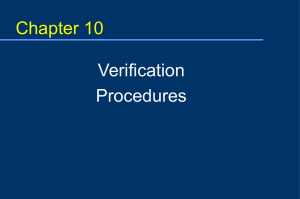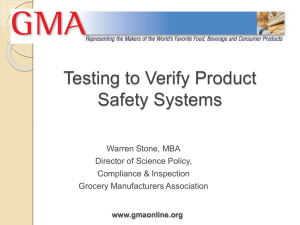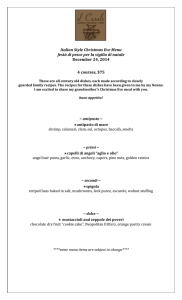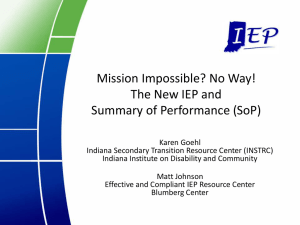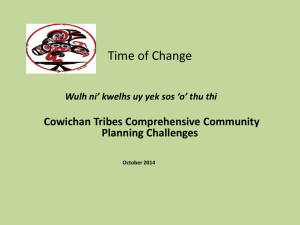Module two
advertisement
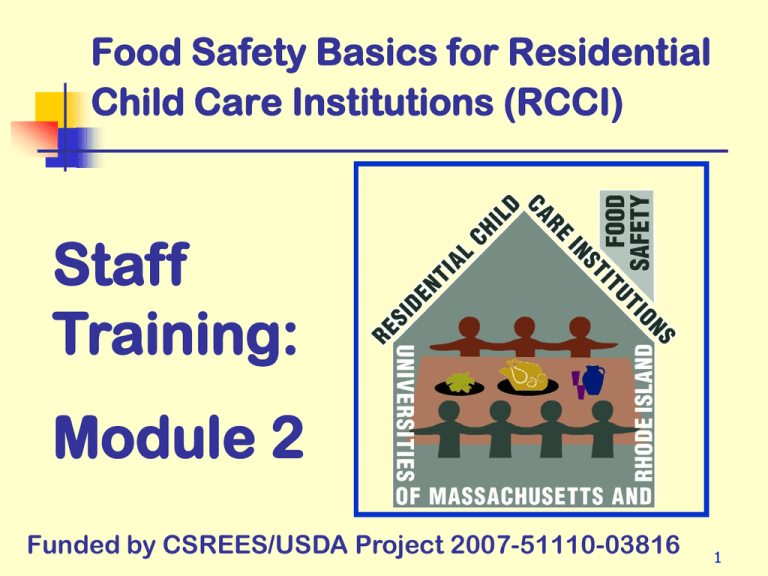
Food Safety Basics for Residential Child Care Institutions (RCCI) Staff Training: Module 2 Funded by CSREES/USDA Project 2007-51110-03816 1 Food Safety Basics for Residential Child Care Institutions (RCCI) Developing a Written Food Safety Plan 2 FEDERAL MANDATE Child Nutrition Act of 2004 requires school foodservice authorities to implement a food safety program beginning July 1,2005 and fully implemented by the end of the 2005/2006 school year. Final rule: 1/14/2010. Includes any agency participating in the National School Lunch and Breakfast Programs such as Residential Child Care Institutions (RCCI) 3 Training program Module 1 Cause and prevention of foodborne illness Strategies to reduce the risk of foodborne illness Module 2 Components of effective Standard Operating Procedures (SOP’s) Components of an effective Food Safety Plan (HACCP) Module 3 Developing a HACCP-based Food Safety Plan and SOP’s Implementing monitoring strategies Using HACCP /food safety resources 4 Getting Started: Purpose of a Food Safety Plan Control of food safety hazards: • From receiving of ingredients to serving and storing food • Throughout the food service environment - personal hygiene, sanitation, cross-contamination, pests etc. 5 Getting Started: Fundamentals of the Program Two parts to a food safety program: • Standard Operating Procedures (SOP’s) • Process Approach to HACCP 6 Let’s Review: FAT TOM What does bacteria need to grow? • • • • • • Food Acidity Time to grow Temperature Oxygen Moisture Let’s Review: Four Food Safety Principles Clean Separate Cook Chill 8 Step 1: Getting Started on a Food Safety Plan Describe the Foodservice Operation 9 Getting Started on a Food Safety Plan • Describe Facility/Equipment • Describe Employees • Describe Residents role • Review current food preparation activities • Review current food safety practices 10 Facility/Equipment Describe facility (e.g. central kitchen, self preparation, satellite) Average number of meals served – breakfast, lunch, dinner Inventory of food preparation equipment 11 Employees/Residents Number of employees/residents at each site and their responsibilities Records of employee/residents training, topics, attendees Any documentation required by state/local health regulatory authority (e.g. food safety manager certification, employee illness reporting agreements) 12 Current Food Preparation Activities • Assemble and organize menus and recipes 13 Recipes Wanted - Reminder Do you have written recipes? You need them! • Uniform production • Used during Food Safety Plan assessments 14 Recipe Sources - Reminder http://www.allrecipes.com http://www.fns.usda.gov/fdd/recipes/ schrecipes.htm http://www.fns.usda.gov/tn/Resources/ usda_recipes.html http://www.nfsmi.org/ResourceOverview. aspx?ID=115 15 Current Food Safety Practices: What is in place? • Are there any food safety-related • • • • records? Are there any written food safety policies? Are there any written purchasing policies? What are the standard operating procedures related to food safety for the facility? Are they written? Is there a food safety plan? Is this written? 16 Step 2: Implementing a Food Safety Program Developing and Implementing Standard Operating Procedures (SOP’s) 17 What are SOP’s? • Practices that support process HACCP and help reduce food safety hazards • Based on food safety guidance or regulation • In place before HACCP can be effective • Non-specific and specific SOP’s • Foundation for employee food safety training 18 SOP’s: Non-specific or Facility-Wide • Written instruction for operations that impact the foodservice environment regardless of product or preparation o Examples of topics for SOP’s Personnel hygiene Cleaning and sanitizing Pest control Preventing cross-contamination Calibration of thermometers Date-marking Storing and labeling chemicals Receiving deliveries 19 SOP’s: Specific General written instructions for the different food preparation processes o o o Not specific menu items Includes written procedures for monitoring and corrections Examples of topics for SOP’s Cooking potentially hazardous food * Cooling potentially hazardous food * Hot and cold holding Reheating Transporting food to satellite sites * TCS - Food 20 Format for Written SOP’s Purpose Instructions Monitoring Corrections Verification/Records Date implemented and by whom Date reviewed and by whom Date revised (if necessary), reviewed and by whom • Signatures 21 Group Activity 1 Description of facility Required SOP’s Checklist 22 Step 3: Implementing a Food Safety Plan Developing and Implementing the Process HACCP Approach 23 Hazard Analysis and Critical Control Point (HACCP) HACCP Purpose: Food Safety Management Control/prevent/minimize food safety hazards that may cause illness or injury: Biological: bacteria, viruses, parasites Chemical: compounds causing illness either immediately or from long-term exposure Physical: foreign objects like metal or glass 25 The HACCP System: A Food Safety Management Tool • Focuses on factors that cause foodborne illness • • Analyzes potential hazards • Determines critical points in process that assures food safety Develops monitoring procedures to confirm safety control 26 HACCP is NOT: • • Crisis management About quality Quality issues do not mean safety problems Safety issues could be present without clear quality indicators 27 HACCP DOES: • Emphasize process control • Concentrate on the points in the process that are critical to the safety of the product • Work to prevent rather then react • Minimize risk and maximize safety 28 STEPS IN DEVELOPING A HACCP PLAN 1) Conduct hazard analysis and identify prevention or control measures 2) 3) 4) 5) Identify critical control points (CCPs) Determine critical limits (CL) Monitor each critical control point/process step Establish corrective action with a critical limit deviation 6) Verify that the food safety plan is working 7) Recordkeeping for critical control points, corrective action and verification HACCP Risk Assessment = Evaluation • Hazard Analysis Risk Management = Control • Critical Control Points • Critical Limits • Monitoring • Corrective Action • Verification • Recordkeeping 31 What is Process HACCP? • HACCP: Food safety management system that focuses on product, preparation and production to reduce food safety hazards • Process HACCP: Basic HACCP principles that are modified for foodservice operations 32 STEPS IN DEVELOPING A PROCESS HACCP PLAN Process HACCP for Foodservice • Assessment (Hazard Analysis) • • • • • Menu review and group by Process Identify control measures Identifying Critical Control Points (CCP) Identifying Critical Limits (CL) Monitoring Critical Control Points Recordkeeping Review 34 Getting Started Beginning risk assessment Procedural Step #1 Group menu items into one (1) of three (3) preparation processes that reflects trips through the “temperature danger zone”. This will begin to group hazards. 35 Categorize Menu Items Trips Through the Danger Zone 135 o F First Second Third 41o F 1No REHEAT Cook Step COOK COOL 2Same Day Service 3Complex Food Prep FDA, Managing Retail Food Safety. FD 2015 36 Food Preparation Action Plan Review menu items and sort by process Process I No Cook Process II Cook & Serve Same Day Process III Complex Food Preparation 37 Flow charts Diagrams that show step-by-step progression of food preparation • Will help to group menu items • May help develop SOP’s (prerequisite programs) common to recipes • Will help identify food flow in recipe/prep procedures into major operational steps Receiving, storing, preparing, cooking, holding etc. 38 Examples of Major Operational Steps Used for Flow Charts • Receiving • Storing • Preparing • Cooking • Cooling • Assembling • Reheating • Holding • Serving FDA, Managing Retail Food Safety. FD 2015 39 Process 1: Food Preparation with No Cook Step Receive Serve Example: Store Prepare Cold Hold Sandwiches w/ “Ready-to-Eat” (RTE) Fillings Canned Tuna Canned Chicken Lunch Meat Fruit salad FDA, Managing Retail Food Safety. FD 2015 40 Process 2: Preparation for Same Day Service Receive Store Serve Prepare Cook Hot Hold Example: Hamburgers Baked Chicken FDA, Managing Retail Food Safety. FD 2015 41 Process 3: Complex Food Preparation Receive Reheat Store Prepare Hot Hold Cook Cool Serve Example: Baked pasta with sauce FDA, Managing Retail Food Safety. FD 2015 42 Categorize Menu Items Trips Through the Danger Zone 135 o F First Second Third 41o F 1No REHEAT Cook Step COOK COOL 2Same Day Service 3Complex Food Prep FDA, Managing Retail Food Safety. FD 2015 43 Example: Flow Chart from Recipe Baked Chicken 1. Chicken breasts are received frozen and stored in the refrigerator until thawed. Chicken is dipped in milk and seasoned bread crumbs. 3. Chicken is baked for 30 minutes at 375o F. 2. 4. Chicken is placed to metal sheet pan and placed under a heat lamp/steam table until served. 5. Chicken is placed on clean plates using tongs and is immediately picked up by residents. 44 Flow Chart for Baked Chicken RECEIVE COOK STORE HOT HOLD PREPARE SERVE SAME DAY PREP FDA, Managing Retail Food Safety. FD 2015 45 Example: Menu Items Sorted by Process PROCESS 1 (NO COOK) Milk Juice Tuna Salad Sandwich Waldorf Fruit Salad Cole Slaw Fresh Fruit Egg Salad Sandwich Broccoli Salad Three Bean Salad Store purchased Chicken or Turkey Salad PROCESS 2 (COOK AND SERVE SAME DAY) Green Beans in Cheese Sauce Chili Macaroni and Cheese Scrambled Eggs Sloppy Joe on Roll Fried Chicken Scalloped Potatoes Chicken Taco Taco Salad Hamburger PROCESS 3 (COMPLEX FOOD PREPARATION) Bean Burrito Bean Soup Potato Salad Baked Pasta Hot turkey sandwich from leftovers Chicken or Turkey salad made from cooked leftovers Source: Modified from Guidance for School Food Authorities. USDA/FNS June 2005 46 Group Activity 2 Sorting menu items in process categories 47 Identifying control measures Procedural Step #2 • Identify significant hazards Biological, Chemical, Physical • Assess likelihood of occurrence • Determine control or prevention methods to eliminate or minimize identified hazards 48 Recognize the Problems: Foodborne illness risk factors Specific – Preparation Process • Inadequate cooking • Inadequate cooling • Improper holding/time-temperature Non-specific – SOP’s (Facility-wide) • Contaminated equipment • Poor personal hygiene • Food from unsafe sources FDA, Managing Retail Food Safety. FD 2015 49 Recognize the Problems: Control Measures for HACCP: • • • • • Proper time/temperature for cooking Proper temperature for hot/cold hold Proper time/temperature for cooling Proper time/temperature for reheating Proper temperature for thawing FDA, Managing Retail Food Safety. FD 2015 50 Procedural Step #3 • Identify and implement Control Measures • Determine Critical Control Points • Establish Critical Limits 51 Critical Control Point (CCP) An operational step in a food preparation process where control measures must be applied to prevent or eliminate or reduce a food safety hazard to an acceptable level. 52 Process 2: Same day service Process 3: Complex Food Preparation Receiving Ready-to-Eat (RTE) Food CCP for temperature control should be at receipt 56 Critical Limits • A critical limit is a criteria or boundary that must be met for each control measure at a CCP. • A maximum and/or minimum value to ensure that the biological, chemical or physical hazard identified at the CCP is controlled. Critical Limit Hazard 57 Determining Critical Limits • Usually established by a regulatory standard FDA Food Code/State-Local regs/USDA • Can be measured, quantified, monitored • Based solely on food safety • May need >1 CL to control a hazard Time and Temperature • Critical Limits vs. Operational Goals Safety vs. Quality 58 Recipes as a Guide • • Using recipes as part of the food safety plan Include critical temperature and time at appropriate food preparation step(s) Preparation steps = CCP Temperature/time = CL 59 USDA: Quantity Recipes for School Food Service National Food Service Management Institute’s website (University of Mississippi): http://www.nfsmi.org/Information/ school_recipe_index_alpha.html Recipes with CCP and CL that fulfill process approach requirements to HACCP 60 Group Activity 3 Determining CCP(s) in one of the menu items from those sorted into process category 2 from Group Activity 2 61 Procedural Steps #4 and #5 • Establish Monitoring Procedures Who, What, When, How Visual, temperature, time Document Track operation/assess that CCP in control • Develop Corrective Actions Correct deviations from CL Determine disposition of food What to do if something goes wrong? Document 62 Thermometer Accuracy/Calibration Importance • Cannot evaluate hot or cold temperature of food without accurate thermometer • Internal temperature only as good as the accuracy and calibration of the thermometer Bimetallic and Digital Ice water or boiling water ? 63 Measuring accuracy of thermometers Recommendations: Measuring cold internal temperature of food: • Ice bath accuracy check • 32 o F Measuring hot internal temperature of food: • Boiling water • 212 o F 64 Group Activity 4 Checking the accuracy of a food thermometer using ice bath Group or Demonstration 65 Scenario 1 PRODUCT: Raw hamburger patty CCP: Cooking* CL: 155ºF for 15 seconds internal temperature and time Burger internal temperature was only 140ºF CA: Continue cooking until patty reaches an internal temperature 155oF for 15 seconds 66 Scenario 2 PRODUCT: Leftover chili CCP: Cooling CL: Cool 135oF to 70oF in 2 hours and 41oF or below within 4 hours Chili is placed in refrigerator in large container and was at 80oF after 1.5 hours CA: Reheat chili to 165 ºF for 15 seconds. Divide and place in small containers in refrigerator, loosely covered. Cool to 70 ºF within 2 hours or less, and to 41 ºF or less in an additional 4 hours. If these times and temperatures are not met, discard 67 Procedural Steps #6 and #7 • Keep Records • Review To validate that the food preparation process chosen results in safe food To routinely verify that the food safety plan is: o o o o being followed working resulting in a safe product being revised as necessary 68 Review to validate • • • • • Initially – to make sure the food preparation or process is doing what it is supposed to do New processes or menu items Changes in suppliers, equipment New food safety information Periodic, at least yearly Monthly audit check recommended 69 Examples of Validation Review • Cooling Chart – Product specific • • • Chicken soup made with broth and vegetables Chicken soup made with cream, (thickened) and vegetables Cooling time records (Appendix) to document rate • Cooking time/temperatures from the Food Code and/or USDA/FNS 70 Review to verify • On-going - daily, weekly, monthly • Review CCP monitoring logs • Review menus periodically Monthly audit checklist Receiving/storage temperature Cooking temperature Cooling temperature Reheating temperature 71 Records • Records documenting SOP’s • • • • Monitoring records (e.g. temperature) Corrective Action records Calibration records Review of records (verification) 72 Examples of Records Food temperature logs Refrigerator temperature logs Freezer temperature logs Sanitizer concentration logs 73 Recipes Wanted – Don’t forget Do you have written recipes? You need them for Module 3 Bring staff training notebook to next training 74 Questions ??? 75 Resources for Illustrations 1. International Association for Food Protection http://www.foodprotection.org/aboutIAFP/S afetyIcons.asp 2. National Registry of Food Safety Professionals, Essentials of Food Safety & Sanitation, 2004 3. Partnership for Food Safety Education. Be Food Safe. http://www.befoodsafe.gov 76
